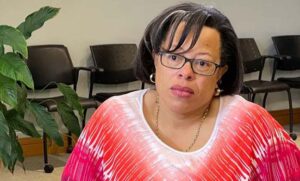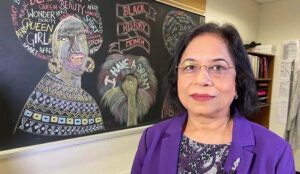
Alyssa Alexander remembers the day a teacher told her class not to use the word “racism.”
It was during a discussion on misrepresentation within the government, she recalls. A classmate suggested systemic racism might be a factor.
“The teacher said, ‘No, we don’t want to use the word racism, it’s just some people have privileges that others don’t.'”
It was an instruction that left Alexander stunned.
As a Black student in the Peel District School Board (PDSB), it’s not the first time the Grade 10 student from Mississauga says racism has been dismissed, overlooked, or ignored in class.
“I’ve had teachers talking about the history of racism, say that it was a myth about how bad Black people were treated during slavery, and how of course, slavery is wrong, but they weren’t actually treated that badly,” she said.

From racial slurs in the hallway to teachers ignorant of their cultural backgrounds, four students spoke at a panel discussion about their personal experiences of anti-Black racism within the Peel board.
Together, the students painted a picture of feeling isolated, alienated and misunderstood in school — whether it was minimizing slavery, being asked why they were in a particular class or teachers assuming they had poor English skills simply because of their accents.
The students believe a key solution is to hire more Black teachers, but say they aren’t sure the board is listening to them.
Exactly what percentage of the PDSB’s workforce is Black isn’t known. The board is conducting a workforce census.
Its last census in 2016 showed seven per cent of staff members identified as Black, while 67 per cent identified as white. That’s in contrast to a 2018 student census, which showed 10 per cent of Peel students were Black, 13 per cent were white.
Nearly 49 per cent of students in that census were South Asian. About five per cent were East Asian, about six per cent were of Middle East descent, and about seven per cent of Peel students were of mixed ethnicity.
The board, meanwhile, doesn’t deny there is systemic racism in its schools — which got so bad that Ontario’s Ministry of Education stepped in to force change in 2019 — and says it’s trying to improve.
The ministry’s review, launched in 2020, found that while Black students in the Peel board make up 10 per cent of the student population, they account for 22 per cent of suspensions. Black youth who spoke with ministry reviewers also said they feel they’re held to a higher standard than white and other racialized students.
After the review, the ministry issued no less than 27 directives for the board it said were aimed at “addressing the systemic discrimination, specifically anti-Black racism; human resources practices; board leadership and governance issues.”
Grade 12 student Amal Elbuluk’s family immigrated from Sudan to Mississauga, where she and her sisters excel academically despite the experiences they continually face.
“I’ve had a substitute teacher apologize to me for where I’m from,” Elbuluk said.
Lidia Tewodros is a Grade 11 student whose family immigrated from Ethiopia. Her younger brother, who has an individual education plan due to his ADHD and autism, was suspended in kindergarten.
“Even though teachers were aware of his condition, they were really aggressive toward him and treated him as if he’s a nuisance,” Tewodros said.
The ministry review noted Black students, especially boys, are perceived as aggressive, with their actions interpreted more negatively. Research quoted in the review says white teachers “may lack awareness of how they will actually respond to discrimination and may be apathetic to negative treatment of Black people.”
Tewodros herself has had students touch her hair without permission, saying the experience made her feel “like a dog.”
When her family arrived in Brampton, school officials insisted she take English as a second language (ESL), even though she spoke the language fluently, was excelling in English class and had a high reading level.
“Because of my accent, and because I was an immigrant, they said I had to go into ESL,” Tewodros said.
Data from the ministry’s review showed a disproportionate number of Black students are streamed into applied courses— meant for students seeking to go to college instead of university — regardless of academic performance. And 25.4 per cent of students in locally developed credit courses — courses meant for students who have perceived gaps in education and need greater support — were Black.
Mahmoud Hassan, a Grade 12 student from Brampton, said he’s one of the few Black males in academic courses required for admission into university.
“I’ve had teachers surprised that I’m in the class,” he said. “I’ve dealt with a lot of microaggressions from teachers, and those are hurtful because you don’t expect it from them.”
Elbuluk recalls when she witnessed a teacher respond to racism in a way that made her and other Black classmates feel valued.
Elbuluk said the teacher had the students sit down and discuss together why what happened was wrong. She also gave Black students a chance to speak about their own experiences as well as what they thought the class could do better.
Rashmi Swarup, the new director of the Peel school board, is overseeing the implementation of the ministry’s directives and expanding the board’s own actions to “eliminate” racism and systemic inequities.
Swarup offered her assurance to parents and students that the board was moving in the “right direction.”
When asked if she could assure parents and students that the board will start listening to their voices, Swarup said “guaranteed.”
Kathy McDonald, a Peel school board trustee and a mother of four Black children, also wasn’t surprised at what the students had to say.
“I’m not shocked by it, but I’m saddened that our kids feel this way and they’re still going through this in 2022,” she said.
But McDonald is hopeful. She believes the ministry’s directives were thoughtful and that when they’re fully implemented, “the students will see a change.”


